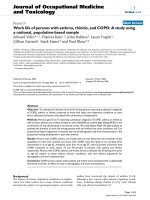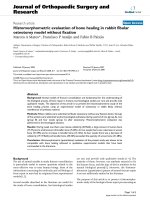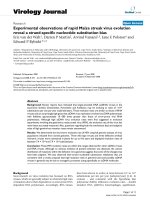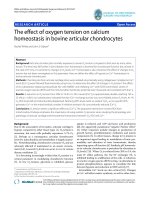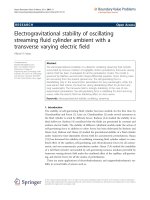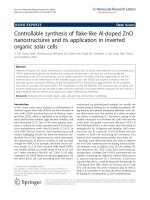Báo cáo hóa học: " Solvothermal synthesis of uniform bismuth nanospheres using poly(N-vinyl-2-pyrrolidone) as a reducing agent" pptx
Bạn đang xem bản rút gọn của tài liệu. Xem và tải ngay bản đầy đủ của tài liệu tại đây (3.72 MB, 8 trang )
NANO IDEA Open Access
Solvothermal synthesis of uniform bismuth
nanospheres using poly(N-vinyl-2-pyrrolidone)
as a reducing agent
Jiliang Wu
1
, Fan Qin
1
, Zhong Lu
1
, Hai-Jian Yang
2
, Rong Chen
1*
Abstract
Uniform bismuth nanospheres were successfully prepared from bismuth nitrate in the presence of poly(N-vinyl-2-
pyrrolidone) (PVP) by solvothermal process. The product was characterized by powder X-ray diffraction, scanning
electron microscopy, transmission electron microscopy, selected area electron diffraction, and energy-dispersive
X-ray. PVP plays a critical role both as a reducing agent and a capping agent in the formation of bismuth
nanospheres. Shape and size of bismuth nanospheres could be tuned by changing the employed PVP/bismuth salt
ratio. It was also found the solvent had an effect on the morphologies of bismuth nanomaterials. The possible
formation and growth mechanism of bismuth nanospheres were also discussed and proposed to explain the
reduction step.
Introduction
Recently, metal nanostructures with functional proper-
ties have been extensively studied due to their wide
applications. Among the va rious metal nanostructures,
monodisperse metallic nanospheres have attracted con-
siderable attention because of their unique optical, cata-
lytic, as well as nov el chemical and biological proper ties
[1-8]. For example, the controlled silver nanospheres
were applied for optical studies and antibac terial appli-
cations [9,10]. Thus, much effort has been devoted to
the preparation of new metal nanospheres and their
functional transformation [11-14]. As a semimetal, bis-
muth has unusual properties due to its highly aniso tro-
pic Fermi surface, low carrier densities, small carrier
effective masses, and long carrier mean free path [15].
Bismuth nanostructures have received steadily growing
interests, since they play important roles in many
diverse applications [16,17]. Different bismuth nanoma-
terials, such as single-crystal bismuth thin film and
nanowire, have been investigated for their large magne-
toresistance, finite-size effects, and enhanced thermal
conductivity [18-20]. It was also reported that spherical
bismuth nanomaterials were a good catalyst for the
growth of SnS
2
nanotubes and germanium nanowires
[21,22].Uptonow,awidevarietyofbismuthnanos-
tructures such as nanoparticles [23], nanowires [24],
nanorods [25], nanotubes [26-28], tria ngular nanoplates
[29], bunch-like nanostructures [17], nanocubes [30], as
well as nanosphere s (>100 n m) [31-34] have been pre-
pared by using different methods. Among these meth-
ods, solvothermal synthesis has become an important
and promising approach to prepare controlled inorganic
nanocrystals [35-37].
In the reported literatures, the alcohol [normally ethy-
lene glycol (EG)] was used as both solvent and reducing
agen t to generate bismuth nanospheres with a wide size
distribution [31-34]. Wang and Xia [38] have developed
the synthesis of uniform bismuth nanospheres by ther-
mal decomposition bismuth acetate in EG under the
protection of ni trogen. The use of protection of inactive
gas and organic metal precursor, however, made it com-
plicated and costly. Hence, a simple, low-cost approach
for the preparation of uniform bismuth nanospheres is
highly desired.
In this communication, we d escribe a solvothermal
process for the synthesis of uniform bismuth nano-
spheres in the presence of poly(N-vinyl-2-pyrrolidone)
(PVP). In most cases, PVP was used as a protecting
agent to cap and stabilize the particles to avoid
* Correspondence:
1
Key Laboratory for Green Chemical Process of Ministry of Education and
School of Chemical Engineering & Pharmacy, Wuhan Institute of Technology,
Wuhan, 430073, P. R. China
Full list of author information is available at the end of the article
Wu et al. Nanoscale Research Letters 2011, 6:66
/>© 2011 Wu et al; licensee Springer. This is an Open Access article distributed under the terms of the Creative Commons Attribution
License ( which permits unrestricted use, distribution, and reproduction in any medium,
provided the original work is properly cited.
aggregation in the solution [39]. It was also reported
tha t PVP was used as reducing agent in the preparation
of noble metallic nanostructures [40,41]. In this synth-
esis, PVP acts as both reducing and capping agent. To
the best of our knowledge, there are few publications
relevant to the synthesis of bismuth nanomaterials using
PVP as a reducing agent.
Experimental
Chemicals
Bismuth nitrate pentahydrate (Bi(NO
3
)
3
·5H
2
O) was
purchased from Fuchen Chemicals Reage nt (China). N,
N-dimethylformamide (DMF), ammonia, mannitol, and
EG were purchased f rom Sinopharm Chemical Reagent
(China); PVP (with average M
w
of 10,000) was purchased
from Sigma-Aldrich Inc. All the reagents were analytical
grade and used directly without further purification.
Synthesis of uniform bismuth nanospheres
In a typical procedure, 0.5 mmol Bi(NO
3
)
3
·5H
2
O was dis-
solved in 12.5 mL of 0.1 mol/L mannitol solution, then
7.5 mL NH
3
·H
2
O (5 mol/L) was added to the solution
slowly with vigorously stirring. After stirring for about
15 min, the white precipitation was collected and washed
with deionized water by centrifugation for five times.
Then the obtained white precipitation and 0.155 g of
PVP were introduced into 35 mL EG. The mixture was
stirred and sonicated until all the chemicals were well
dispersed. Then it w as transferred into a stainless steel
autoclave with Teflon liner. The autoclave was sealed and
maintained at 180°C for 12 h. After cooling to room tem-
perature, the obtained black solution was centrifuged and
the solid product was collected. The black solid product
was then washed with absolute alcohol for five to seven
times followed by centrifugation. Finally, the so lid pro-
duct was dried in a desiccator for a few days for further
characterization (sample 1). Other samples of bismuth
nanomaterials were also prepared with different amounts
of PVP and different solvents using the same methods
under identical conditions (Table 1).
Characterizations
The bismuth nanostr uctures were characterize d by pow-
der X-ray diffraction (XRD), scanning electron
microscopy (SEM), transmission electron microscopy
(TEM), selected area electron diffraction (SAED), and
energy-dispersive X-ray (EDX). The powder XRD pattern
was recorded on Bruker AXS D8 Discover (Cu Ka radia-
tion, l = 1.5406 Å). The scanning rate is 1°/min in the 2θ
range from 20 to 70°. The SEM images were taken on a
Hitachi S4800 field emission scanning electron micro-
scope operating at 3 or 5 kV (FESEM, Japan). TEM
images and SAED pictures were recorded on a Philips
Technai G2 20 electron microscope (Manufacturer: FEI
Company), using an accelerating voltage of 200 kV. The
EDX analysis was performed on an Oxford Instruments
Inca with a scanning range from 0 to 20 keV. The sam-
ples for TEM observations were prepared by dispersing
some of the solid products into absolute alcohol and then
sonicated for several minutes. A few drops of the suspen-
sion were deposit ed on the copper grid, which was then
put into the desiccator. The thermogravimetric and dif-
ferential analysis was done by DIAMOND TG/DTA
instrument (PerkinElmer Instruments, Waltham, CT,
USA) with a heating rate of 10°C/min.
Results and discussion
Figure 1a shows the typical powder XRD pattern of the
as-synthesized product (sample 1). All the diffraction
peaks could be readily indexed to be rhombohedral
phase of bismuth, which were consistent with the litera-
ture values (JCPDS No. 05-0519). No impurity was
detected in this pattern, indicating the formation of
pure bismuth products under current synthetic condi-
tion. The sharp and strong diffraction peaks also con-
firm the well crystallization of the products.
The morphologies and structures of the as-prepared bis-
muth nanospheres were investigated by SEM and TEM
images. Figure 1b, c, d shows the representative SEM
images of the as-prepared bismuth nanospheres with
different magnifications. The low-magnification images
(Figure 1b, c) indicate the large production of uniform bis-
muth nanospheres. No other bismuth morphologies could
be found in the whole sample. The diameters of these
nanospheres varied from 160 to 210 nm and most of them
were about 180 nm. The high-magnification image shown
in Figure 1d clearly reveals the detailed morphologies of
the products, indicating the formation of uniform, regular
nanospheres with smooth surfaces.
The low- (Figure 2a) and high-magnification (Figure 2b)
TEM images further demonstrated the morphologies of
these bismuth nanospheres clearly. It also reveals a well
defined spheric structure and smooth surface. The statisti-
cal analysis showed that bismuth nanospheres had a
narrow size distribution and the average diameter was
about 180 nm with a standard deviation of 10 nm (Figure
2c). SAED pattern taken from an individual bismuth parti-
cle showed clear diffraction spots, indicating a good
Table 1 Experimental conditions for the synthesis of
bimuth nanomaterials
Sample number The amount of PVP (g) Solvent
1 0.155 EG
2 0EG
3 0.310 EG
4 0.465 EG
5 0.155 DMF
Wu et al. Nanoscale Research Letters 2011, 6:66
/>Page 2 of 8
single-crystal structure (Figure 2d). The elemental compo-
sition of the nanosphe res was also analyzed by EDX, and
characteristic bismuth absorption peaks were observed
(Figure S1 in Additional File 1). The copper and carbon
peaks are due to the carbon-coated copper grid.
To investigate the composition of the white preci pitat e
obtained in the synthetic procedure, thermogravimetric
and differential thermal analysis (TG/DTA) and EDX
measurements were carried out. Figure 3a shows the
results of the thermal analysis of the white precipitate at a
heating rate of 10°C/min in the nitrogen atmosphere. It
indicates a two-step weight loss in the temperature range
from 25 to 200 and 200 to 300°C. The first weight loss in
the TG trace could be attributed to the desorption of phy-
sically adsorbed water, and the second one could be recog-
nized in according with the e xothermal reaction in DT A
trace (Figure 3a). The exothermal reaction thermal was
found to arise from the decomposition of the white preci-
pitate. The white precipitate was further investigated by
EDX spectrum. As shown in Figure 3b, the white precipi-
tate was composed of Bi, O, and C and no other additional
elements were detected. The Si signal is attributed to the
silicon wafers. When the white precipitate was calcined at
350°C for 90 min, the XRD pattern of the calcined product
was very close to the standard data (Bi
2
O
3
, JCPDS No. 71-
2274) (Figur e S2 in Additional File 2). Hence, it was pro-
posed that the possible component of the white precipitate
was bismuth complexes (Bi
III
-mannitol), which were
formed in ammonia solution.
In this study, it was found that there was no blac k pro-
duct precipitated from the solution in the absence of
PVP under identical experiment condition. The XRD pat-
tern of the obtained white product could not be assign ed
in the XRD standard data base (Figure S3 in Additional
File 3). It is obvious that PVP plays a key role in the
formation of bismuth nanospheres. It was proposed
that PVP reduced Bi
3+
ions to give metallic bismuth.
The reduction process could be probably understood
considering two main reactions: (1) direct abstraction
of hydrogen atoms from the polymer by the Bi
3+
ions;
(2) reduction of the Bi
3+
ions by the organic radicals formed
in (1) or during the bismuth-accelerated degrad ation of
PVP, which is similar to the reported literatures [40,42]. It
was reported that the capping organic molecules in the
reaction system could determine the subsequent mor-
phology of the product because of their special chemical
Figure 1 XRD pattern (a) and SEM images of the as-synthesized product in EG at lower (b, c) and higher (d) magnifications (sample 1).
Wu et al. Nanoscale Research Letters 2011, 6:66
/>Page 3 of 8
properties and self-assembling functions [43-45]. Recently,
it was also found that EG molecules could adsorb onto the
surface of bismuth crystals through O-Bi bonding which
could significantly decrease their growth rates and lead to
highly anisotropic growth [33,46]. Thus, when the molar
ratio of repeating units of PVP to Bi
3+
is about 3, that is,
there is no excess PVP in the solution, these uniform bis-
muth na nosph eres can be obtained un der the only effect of
EG.
(1)
(2)
When the amount of PVP was increased to 0.310 g
(the molar ratio of repeating units of PVP t o Bi
3+
is
about 6), bismuth nanospheres and nanowires were
formed, as shown in Figure 4a. The diameters of
obtained bismuth na nospheres were in the range from
250 to 500 nm, and the length of t he nanowires varies
from 0.5 to more than 6 μm. When the molar ratio of
repeating units of PVP to Bi
3+
was further increase d to
about 9 (the amount of PVP is 0.465 g), a mass of bis-
muth nanowires were obtained and few bismuth nano-
spheres remained, as shown in Figure 4b. The length of
bismuth nanowires is up to 10 μmandthediametersof
nanospheres are in range from 200 to 500 nm. The ele-
mental composition of these nanowires and few nano-
spheres was also analyzed by EDX, and characteristic
bismuth absorption peaks were observed (Figure 4e).
Thus, PVP is considered to act both as reducing agent
and capping agent in this synthesis. It was belie ved that
the formation of bismuth nanowires was based on the
Ostwald ripening process [47,48]. At first, bismuth
nanoparticles were f ormed in the solution according to
eqs 1 or 2 with PVP as reducing or nucleatin g agent.
Then, the excess PVP molecules could cap onto the
Figure 2 Typical (a) low- and (b) high-magnification TEM images of as-prepared bismuth nanospheres (sample 1). (c) The histogram of
size distribution of the bismuth nanospheres prepared from “a” . (d) The SAED pattern of a single bismuth nanosphere.
Wu et al. Nanoscale Research Letters 2011, 6:66
/>Page 4 of 8
surface of bismuth particles [33], and bismuth nanowires
were produced through this polyol process. In this pro-
cess, bismuth particles can continuously grow into
nanospheres, nanorods, or nanowires. The co-effect of
PVP and EG resulted in a wide size distribution of the
diameter of bismuth nanospheres in this experiment
and literatures [31-33].
Interestingly, when DMF was instead of EG, bismuth
nanoparticles and nanotubes arrays were formed under
identical experimental conditions (Figure 4c, d). The
average diameter of bismuth nanoparticles i s about
50 nm, and the d iameters of the bismuth nanot ubes are
in a narrow range from about 3.2 to 5.2 nm, with an
average diameter of 4.3 nm. EDX was used to further
analyze the elemental compositions of these nanotubes
lying o n the hole of the copper grid. It reveals the
elemental Bi signals and confirmed the purity of this
bismuth nanotube (Figure 4f). The copper and carbon
peaks are due to the carbo n-coated copper grid. Here,
DMF plays an important role in the fabrication of bis-
muth nanotubes. In this synthesis, the starting materials
can dissolve in DMF and DMF can partially decompose
into dimethylamine, which is a good coordination ligand
with N-chelation. The diffusion of Bi
3+
ions in DMF-
dimethylamine will be faster due to its lower viscosity,
which is ben eficial for the formation of nanotube pro-
ducts [49]. The formation mechanism is still limited and
further study in progress.
Conclusions
In summary, uniform bismuth nanospheres were suc-
cessfully synthesized via a facile solvothermal process
Figure 3 Thermogravimetric and differential thermal analysis (TG/DTA) and EDX Analysis (a) TG/DTA curves of thermal decomposition
of the white precipitation at a heating rate of 10°C/min in the N
2
atmosphere; (b) EDX pattern of the white precipitation.
Wu et al. Nanoscale Research Letters 2011, 6:66
/>Page 5 of 8
by reduction of EG solution of bismuth salt, using PVP
both as a reducing agent and a capping agent. The
shapes and sizes of the bismuth nanostructures varied
with the changing of the PVP/bismuth salt molar ratio.
Uniform bismuth nanospheres with an average dia-
meter of 180 nm could be routinely synthesized
through this solvothermal approach by controlling the
PVP/bismuth salt ratio. The solvent EG also played an
importantroleintheformationofuniformbismuth
nanospheres. Bismuth nanoparticles and nanotubes
were formed w hen DMF w as used as a solvent instead
of EG. The possible formation mechanism of the bis-
muth nanotubes was also discussed and further study
was in progress.
Figure 4 SEM (a) image of bismuth nanomaterials were obtained when the amount of PVP was 0.310 g (sample 3). SEM image (b) and
EDX pattern (e) of bismuth nanomaterials were obtained when the amount of PVP was 0.465 g (sample 4). Typical low- (c), high-magnification
(d) TEM images, and EDX spectrum (f) of the bismuth nanostructures using DMF instead of EG as solvent (sample 5).
Wu et al. Nanoscale Research Letters 2011, 6:66
/>Page 6 of 8
Additional material
Additional file 1: Figure S1. EDX spectrum of bismuth nanospheres
prepared in EG.
Additional file 2: Figure S2. XRD pattern of the white precipitation was
calcined at 350°C for 90 min.
Additional file 3: Figure S3. XRD pattern of the white product obtained
in EG in the absence of PVP.
Abbreviations
DMF: N,N-dimethylformamide; EDX: energy-dispersive X-ray; EG: ethylene
glycol; PVP: poly(N-vinyl-2-pyrrolidone); SAED: selected area electron
diffraction; SEM: scanning electron microscopy; TEM: transmission electron
microscopy; XRD: X-ray diffraction.
Acknowledgements
This study was supported by National Natural Science Foundation of China
(Grant 20801043), the Program for New Century Excellent Talents in
University (NCET-09-0136), and the Outstanding Youth Scientific Foundation
of Hubei Province (2009CDA075).
Author details
1
Key Laboratory for Green Chemical Process of Ministry of Education and
School of Chemical Engineering & Pharmacy, Wuhan Institute of Technology,
Wuhan, 430073, P. R. China
2
Key Laboratory of Catalysis and Materials
Science of the State Ethnic Affairs Commission & Ministry of Education,
College of Chemistry and Materials Science, South-Central University for
Nationalities, Wuhan, 430074, P. R. China
Authors’ contributions
JW participated in the acquisition of data and drafted the manuscript. FQ
carried out the SEM characterization and participated the analysis and
interpretation of data. ZL and HJY helped to draft and revise the manuscript.
RC made contributions to conception and design of the study, revised the
manuscript critically for important intellectual content, and has given final
approval of the version to be published.
Competing interests
The authors declare that they have no competing interests.
Received: 26 July 2010 Accepted: 12 January 2011
Published: 12 January 2011
References
1. Bigall NC, Härtling T, Klose M, Simon P, Eng LM, Eychmüller A: Monodisperse
platinum nanospheres with adjustable diameters from 10 to 100 nm:
Synthesis and distinct optical properties. Nano Lett 2008, 8:4588.
2. Schwartzberg AM, Olson TY, Talley CE, Zhang JZ: Synthesis,
characterization, and tunable optical properties of hollow gold
nanospheres. J Phys Chem B 2006, 110:19935.
3. Semagina N, Kiwi-Minsker L: Palladium nanohexagons and nanospheres
in selective alkyne hydrogenation. Catal Lett 2009, 127:334.
4. Lee S, Chon H, Lee M, Choo J, Shin SY, Lee YH, Rhyu IJ, Son SW, Oh CH:
Surface-enhanced raman scattering imaging of HER2 cancer markers
overexpressed in single MCF7 cells using antibody conjugated hollow
gold nanospheres. Biosens Bioelectron 2009, 24:2260.
5. Nitin N, Javier DJ, Roblyer DM, Richards-Kortum R: Widefield and high-
resolution reflectance imaging of gold and silver nanospheres. J Biomed
Opt 2007, 12:051505.
6. Skala MC, Crow MJ, Wax A, Izatt JA: Photothermal optical coherence
tomography of epidermal growth factor receptor in live cells using
immunotargeted gold nanospheres. Nano Lett 2008, 8:3461.
7. Li W, Camargo PHC, Lu X, Xia Y: Dimers of silver nanospheres: Facile
synthesis and their use as hot spots for surface-enhanced raman
scattering. Nano Lett 2008, 9:485.
8. Chon H, Lee S, Son SW, Oh CH, Choo J: Highly sensitive immunoassay
of lung cancer marker carcinoembryonic antigen using surface-
enhanced raman scattering of hollow gold nanospheres. Anal Chem
2009, 81:3029.
9. Cobley CM, Rycenga M, Zhou F, Li ZY, Xia Y: Controlled etching as a route
to high quality silver nanospheres for optical studies. J Phys Chem C
2009, 113:16975.
10. Lok C-N, Ho C-M, Chen R, He Q-Y, Yu W-Y, Sun H, Tam PK-H, Chiu J-F,
Che C-M: Proteomic analysis of the mode of antibacterial action of silver
nanoparticles. J Proteome Res 2006, 5:916.
11. Jia FL, Zhang LZ, Shang XY, Yang Y: Non-aqueous sol-gel approach
towards the controllable synthesis of nickel nanospheres, nanowires,
and nanoflowers. Adv Mater 2008, 20:1050.
12. Goy-López S, Castro E, Taboada P, Mosquera Vc: Block copolymer-
mediated synthesis of size-tunable gold nanospheres and nanoplates.
Langmuir 2008, 24:13186.
13. Xiao C-W, Shen C-M, Xu Z-C, Yang T-Z, Gao H-J: Anomalous aggregation
growth of palladium nanosphere with spr band in visible range. Chin
Phys B 2008, 17:2066.
14. Lee C-L, Kuo L-C, Huang Y-C, Yen Y-W: Mesoporous, self-assembled
palladium nanospheres: High efficiency activator for electroless nickel
deposition. Electrochem Commun 2006,
8:697.
15.
Yang FY, Liu K, Chien CL, Searson PC: Large magnetoresistance and finite-
size effects in electrodeposited single-crystal Bi thin films. Phys Rev Lett
1999, 82:3328.
16. Carotenuto G, Hison C, Capezzuto F, Palomba M, Perlo P, Conte P:
Synthesis and thermoelectric characterisation of bismuth nanoparticles.
J Nanoparticle Res 2009, 11:1729.
17. Zhang Z, Yu K, Bai D, Zhu Z: Synthesis and electrochemical sensing
toward heavy metals of bunch-like bismuth nanostructures. Nanoscale
Res Lett 2010, 5:398.
18. Boukai A, Xu K, Heath JR: Size-dependent transport and thermoelectric
properties of individual polycrystalline bismuth nanowires. Adv Mater
2006, 18:864.
19. Huber TE, Nikolaeva A, Gitsu D, Konopko L, Graf MJ: Role of boundary
roughness in the electronic transport of Bi nanowires. J Appl Phys 2008,
104:123704.
20. Moore AL, Pettes MT, Zhou F, Shi L: Thermal conductivity suppression in
bismuth nanowires. J Appl Phys 2009, 106:034310.
21. Yella A, Mugnaioli E, Panthöfer M, Therese HA, Kolb U, Tremel W: Bismuth-
catalyzed growth of SnS
2
nanotubes and their stability. Angew Chem Int
Ed 2009, 48:6426.
22. Xiang Y, Cao L, Arbiol J, Brongersma ML, Fontcuberta i Morral A: Synthesis
parameter space of bismuth catalyzed germanium nanowires. Appl Phys
Lett 2009, 94:163101.
23. Wang F, Tang R, Yu H, Gibbons PC, Buhro WE: Size- and shape-controlled
synthesis of bismuth nanoparticles. Chem Mater 2008, 20:3656.
24. Xu Y, Ren Z, Ren W, Cao G, Deng K, Zhong Y: Magnetic-field-assisted
solvothermal growth of single-crystalline bismuth nanowires.
Nanotechnology 2008, 19:115602.
25. Cao S, Guo C, Wang Y, Miao J, Zhang Z, Liu Q: Template-catalyst-free
growth of single crystalline bismuth nanorods by RF magnetron
sputtering method. Solid State Commun 2009, 149:87.
26. Yang D, Meng G, Xu Q, Han F, Kong M, Zhang L: Electronic transport
behavior of bismuth nanotubes with a predesigned wall thickness.
J Phys Chem C 2008, 112:8614.
27. Derrouiche S, Zoican Loebick C, Wang C, Pfefferle L: Energy-induced
morphology changes in bismuth nanotubes. J Phys Chem C 2010,
114:4336.
28. Boldt R, Kaiser M, Köhler D, Krumeich F, Ruck M: High-yield synthesis and
structure of double-walled bismuth-nanotubes. Nano Lett 2010, 10:208.
29. Fu R, Xu S, Lu Y-N, Zhu JJ: Synthesis and characterization of triangular
bismuth nanoplates. Cryst Growth Des 2005, 5:1379.
30. Wang WZ, Poudel B, Ma Y, Ren ZF: Shape control of single crystalline
bismuth nanostructures. J Phys Chem B 2006, 110:25702.
31. Cheng G, Wu J, Xiao F, Yu H, Lu Z, Yu X, Chen R: Synthesis of bismuth
micro- and nanospheres by a simple refluxing method. Mater Lett 2009,
63:2239.
32. Li J, Fan H, Chen J, Liu L: Synthesis and characterization of poly(vinyl
pyrrolidone)-capped bismuth nanospheres. Colloids Surf A 2009, 340:66.
33. Wang J, Wang X, Peng Q, Li Y: Synthesi s and characterization of
bismuth single-crystalline nanowires and nanospheres. Inorg Chem
2004, 43:7552.
Wu et al. Nanoscale Research Letters 2011, 6:66
/>Page 7 of 8
34. Wu J, Yang H, Li H, Lu Z, Yu X, Chen R: Microwave synthesis of bismuth
nanospheres using bismuth citrate as a precursor. J Alloys Compd 2010,
498:L8.
35. Wang X, Zhuang J, Peng Q, Li Y: A general strategy for nanocrystal
synthesis. Nature 2005, 437:121.
36. Nikolopoulou A, Papoulis D, Komarneni S, Tsolis-Katagas P, Panagiotaras D,
Kacandes GH, Zhang P, Yin S, Sato T: Solvothermal preparation of TiO
2
/
saponite nanocomposites and photocatalytic activity. Appl Clay Sci 2009,
46:363.
37. Gao F, Lu Q, Komarneni S: Interface reaction for the self-assembly of
silver nanocrystals under microwave-assisted solvothermal conditions.
Chem Mater 2005, 17:856.
38. Wang Y, Xia Y: Bottom-up and top-down approaches to the synthesis of
monodispersed spherical colloids of low melting-point metals. Nano Lett
2004, 4:2047.
39. Komarneni S, Li D, Newalkar B, Katsuki H, Bhalla AS: Microwave-polyol
process for Pt and Ag nanoparticles. Langmuir 2002, 18:5959.
40. Hoppe CE, Lazzari M, Pardinas-Blanco I, Lopez-Quintela MA: One-step
synthesis of gold and silver hydrosols using poly(N-vinyl-2-pyrrolidone)
as a reducing agent. Langmuir 2006, 22:7027.
41. Chen J, Lim B, Lee EP, Xia Y: Shape-controlled synthesis of platinum
nanocrystals for catalytic and electrocatalytic applications. Nano Today
2009, 4:81.
42. Kaczmarek H, Kamińska A, Światek M, Rabek JF: Photo-oxidative
degradation of some water-soluble polymers in the presence of
accelerating agents. Die Angew Makromol Chem 1998, 261-262:109.
43. Bombicz P, Mutikainen I, Krunks M, Leskelä T, Madarász J, Niinistö L:
Synthesis, vibrational spectra and X-ray structures of copper(I) thiourea
complexes. Inorg Chim Acta 2004, 357:513.
44. Peng X, Manna L, Yang W, Wickham J, Scher E, Kadavanich A, Alivisatos AP:
Shape control of CdSe nanocrystals. Nature 2000, 404:59.
45. Lee S-M, Cho S-N, Cheon J: Anisotropic shape control of colloidal
inorganic nanocrystals. Adv Mater 2003, 15:441.
46. Wang YW, Hong BH, Kim KS: Size control of semimetal bismuth
nanoparticles and the UV-visible and IR absorption spectra. J Phys Chem
B 2005, 109:7067.
47. Yin Y, Alivisatos AP: Colloidal nanocrystal synthesis and the organic-
inorganic interface. Nature 2005, 437:664.
48. Alivisatos AP: Semiconductor clusters, nanocrystals, and quantum dots.
Science 1996, 271:933.
49. Wei G, Deng Y, Lin Y-H, Nan C-W: Solvothermal synthesis of porous
tellurium nanotubes. Chem Phys Lett 2003, 372:590.
doi:10.1186/1556-276X-6-66
Cite this article as: Wu et al.: Solvothermal synthesis of uniform
bismuth nanospheres using poly(N-vinyl-2-pyrrolidone) as a reducing
agent. Nanoscale Research Letters 2011 6:66.
Submit your manuscript to a
journal and benefi t from:
7 Convenient online submission
7 Rigorous peer review
7 Immediate publication on acceptance
7 Open access: articles freely available online
7 High visibility within the fi eld
7 Retaining the copyright to your article
Submit your next manuscript at 7 springeropen.com
Wu et al. Nanoscale Research Letters 2011, 6:66
/>Page 8 of 8

